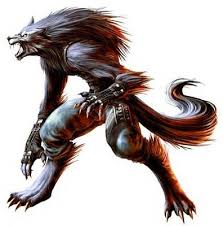
I got an email from James Mayhark who wanted me to take a look at his lycanthrope kindred and type for Tunnels and Trolls. Were-creatures are actually covered in 5th edition, but are in no way this in depth, generally having double-stats when they 'were-out'. Here James has gone for the double-whammy, with some great rules for both a kindred and a type. Maybe it's just me but I prefer the lycanthrope as a kindred, but he's thought up some really cool ideas to use it as a type. Check it out:
New Kindred: Lycanthrope
Half-Wolf (Werewolf)
Lycanthropy (derrived from the greek "lykanthropos", 'lykos' being "wolf" and 'anthropos' being "human") is the state of a human sharing and existance as a wolf, as well as any other given animal (the term 'lycanthropy' techinically being specific to werewolves is also loosely applied to describe other were-animals in the place of the proper term 'therianthropy'). It is looked upon as a curse and a power as they find abilities that their animal sides grant, as well as the dreaded animalistic rage and instinct widely accepted to couple lycanthropy.
Attributes*
ST x2
DX x3/2
CH x1/2
CN x3/2
IQ x1
SP x1
LK x1/2
WZ x1
*Players may choose to partake of an animal other than wolf in their lycanthropy. Also, if the player chooses, and with the GM's consent, the player may relocate the modifiers above as it would seem fitting for their animal of choice (for example, a werebat may be faster than a werewolf, but would also be slightly more frail. This would allow for a greater dexterity bonus, but also a lowered constitution.).
Special Abilities
Great Strength: Wielding two handed weapons in one hand requires no extra Strength or dexterity. Also, when dual wielding weapons, instead of requiring a combined Strength and Dexterity requirement totals, Lycanthropes only have to meet the requirements individually.
Wild Communion: Lycanthropes can communicate with animals (but only on a verbal-type principle, not on a psychic level such as seeing into memories, or sensing feelings from afar).
Beastial Fury: Any weapon weilded by a Lycanthrop only gets half (x1/2) (rounded down) the ADDS bonuses for combat, as their fury does not allow them to wield them to their full potential, resulting in enraged hacking and slashing. (Note that the amount of DICE is unaffected)
Beastial Fury 2: Lycanthropic rage also effects the focus and control of a lycanthrope, and does not allow them to practice a given occupation. Therefor, lycanthropes cannot be considered to be a certain character type or class aside from "lycanthrope".
Lycanthrope "Class" info
Prerequisites: 13+ STR and DEX
Prime Attributes: STR/DEX/CON
Lycanthropes start with 1d6x10 gold
Talents:
Lycanthropes start with one talent of the players choosing, and earn talents the same as the other classes listed in the book. Lycanthropes may, like warriors, may use their talents to gain combat adds.
Lycans automatically learn their spells at the propper level. They may also learn, but not automatically, spells the same as rogues can, as demarked in the book.
Spells:
Level 1
Shifting- Costs 1- The player shifts into animal form. Constitution is temporarily reduced by 3, but the player gets a +7 bonus in an appropriate attribute (depending on animal, ultimately the GM's discretion) while in animal form.
Improved Sense- Costs 2- make either a Luck or Intelligence level 1 Saving Roll to sharpen your senses, allowing you to figure out traps, detect enemies in hiding, or to add 5 dexterity for a single encounter.
Regenerate- Costs 1 per 3 health- you MUST regenerate fully when using this spell, and therefor must calculate the cost of the entirety of your missing health.
Level 3
Partial Shifting- Costs 2- Shift part of your body (such as a hand) to make claws, giving you +4 combat adds for a single encounter. You may spend 2 points more to shift both both hands/multiple body parts to receive +4 more combat adds for the encounter. This spell may be cast in addition to attacking during your turn in combat.
Poison Fang- costs 4- If your animal is considered poisonous (snakes, spiders, ect) then you may use this spell as your attack, inflicting 1d6+4 of damage (plus normal combat adds, NOT including that of weaponry) and poison your enemy. Make a Level 1 Saving Roll for dexterity to determine weather the attack is landed or not. Your opponent takes 1-3 damage during their turn (roll one d6 and divide the number in two, rounded UP, to determine the damage done by poisoning)
Level 5
Animal control- Costs 7- Roll one d6. On a 1 or 2, you get a single animal from your surroundings with an MR equal to 3d6 each. On a 3 or 4, you may get 2 animals with MR equal to 3d6 each. On a five, you get 3 animals with MR Equal to 3d6 each. On a 6, you get 3 animals with MR equal to 4d6+1 each. Note that you roll the given amount of dice for each animal SEPARATELY.
Special blood- Costs varies- You may heal another character back to full health through the sacrifice of an amount of your precious blood. The cost for this spell is equal to half the recovered health in both power and constitution (to a maximum of 6 each)(you must heal the character back to full health)
Level 7
Summon Spirit- Costs 9- Summon forth the spirit of your ancient kin to support you in battle. The spirit's MR is equal to 5d6+7 and has a natural armor of 2 protection.





